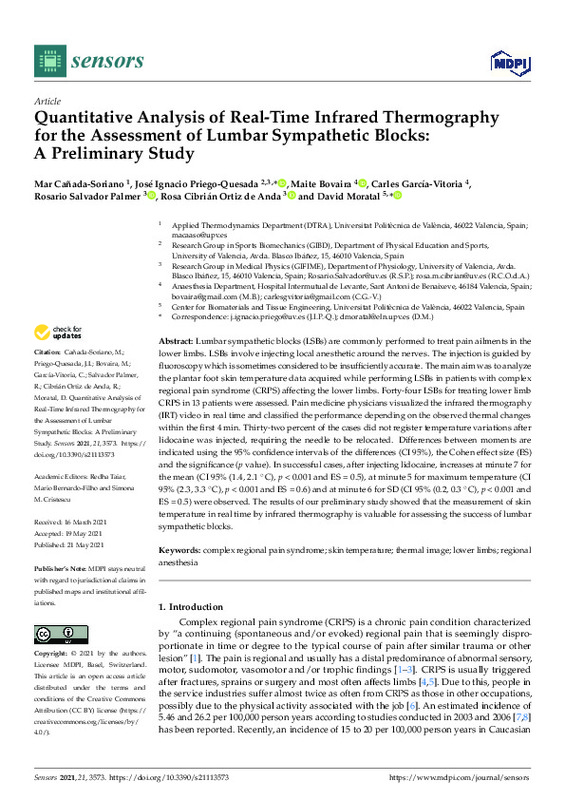JavaScript is disabled for your browser. Some features of this site may not work without it.
Buscar en RiuNet
Listar
Mi cuenta
Estadísticas
Ayuda RiuNet
Admin. UPV
Quantitative Analysis of Real-Time Infrared Thermography for the Assessment of Lumbar Sympathetic Blocks: A Preliminary Study
Mostrar el registro sencillo del ítem
Ficheros en el ítem
| dc.contributor.author | Cañada-Soriano, Mar
|
es_ES |
| dc.contributor.author | Priego-Quesada, Jose Ignacio
|
es_ES |
| dc.contributor.author | Bovaira, Maite
|
es_ES |
| dc.contributor.author | García-Vitoria, Carles
|
es_ES |
| dc.contributor.author | Salvador Palmer, Rosario
|
es_ES |
| dc.contributor.author | Ortiz de Anda, Rosa Cibrián
|
es_ES |
| dc.contributor.author | Moratal, David
|
es_ES |
| dc.date.accessioned | 2022-03-23T19:03:34Z | |
| dc.date.available | 2022-03-23T19:03:34Z | |
| dc.date.issued | 2021-06 | es_ES |
| dc.identifier.uri | http://hdl.handle.net/10251/181522 | |
| dc.description.abstract | [EN] Lumbar sympathetic blocks (LSBs) are commonly performed to treat pain ailments in the lower limbs. LSBs involve injecting local anesthetic around the nerves. The injection is guided by fluoroscopy which is sometimes considered to be insufficiently accurate. The main aim was to analyze the plantar foot skin temperature data acquired while performing LSBs in patients with complex regional pain syndrome (CRPS) affecting the lower limbs. Forty-four LSBs for treating lower limb CRPS in 13 patients were assessed. Pain medicine physicians visualized the infrared thermography (IRT) video in real time and classified the performance depending on the observed thermal changes within the first 4 min. Thirty-two percent of the cases did not register temperature variations after lidocaine was injected, requiring the needle to be relocated. Differences between moments are indicated using the 95% confidence intervals of the differences (CI 95%), the Cohen effect size (ES) and the significance (p value). In successful cases, after injecting lidocaine, increases at minute 7 for the mean (CI 95% (1.4, 2.1 °C), p < 0.001 and ES = 0.5), at minute 5 for maximum temperature (CI 95% (2.3, 3.3 °C), p < 0.001 and ES = 0.6) and at minute 6 for SD (CI 95% (0.2, 0.3 °C), p < 0.001 and ES = 0.5) were observed. The results of our preliminary study showed that the measurement of skin temperature in real time by infrared thermography is valuable for assessing the success of lumbar sympathetic blocks. | es_ES |
| dc.language | Inglés | es_ES |
| dc.publisher | MDPI AG | es_ES |
| dc.relation.ispartof | Sensors | es_ES |
| dc.rights | Reconocimiento (by) | es_ES |
| dc.subject | Complex regional pain syndrome | es_ES |
| dc.subject | Lower limbs | es_ES |
| dc.subject | Regional anesthesia | es_ES |
| dc.subject | Skin temperature | es_ES |
| dc.subject | Thermal image | es_ES |
| dc.title | Quantitative Analysis of Real-Time Infrared Thermography for the Assessment of Lumbar Sympathetic Blocks: A Preliminary Study | es_ES |
| dc.type | Artículo | es_ES |
| dc.identifier.doi | 10.3390/s21113573 | es_ES |
| dc.rights.accessRights | Abierto | es_ES |
| dc.description.bibliographicCitation | Cañada-Soriano, M.; Priego-Quesada, JI.; Bovaira, M.; García-Vitoria, C.; Salvador Palmer, R.; Ortiz De Anda, RC.; Moratal, D. (2021). Quantitative Analysis of Real-Time Infrared Thermography for the Assessment of Lumbar Sympathetic Blocks: A Preliminary Study. Sensors. 21(11):1-17. https://doi.org/10.3390/s21113573 | es_ES |
| dc.description.accrualMethod | S | es_ES |
| dc.relation.publisherversion | https://doi.org/10.3390/s21113573 | es_ES |
| dc.description.upvformatpinicio | 1 | es_ES |
| dc.description.upvformatpfin | 17 | es_ES |
| dc.type.version | info:eu-repo/semantics/publishedVersion | es_ES |
| dc.description.volume | 21 | es_ES |
| dc.description.issue | 11 | es_ES |
| dc.identifier.eissn | 1424-8220 | es_ES |
| dc.identifier.pmid | 34063768 | es_ES |
| dc.identifier.pmcid | PMC8196638 | es_ES |
| dc.relation.pasarela | S\439908 | es_ES |








